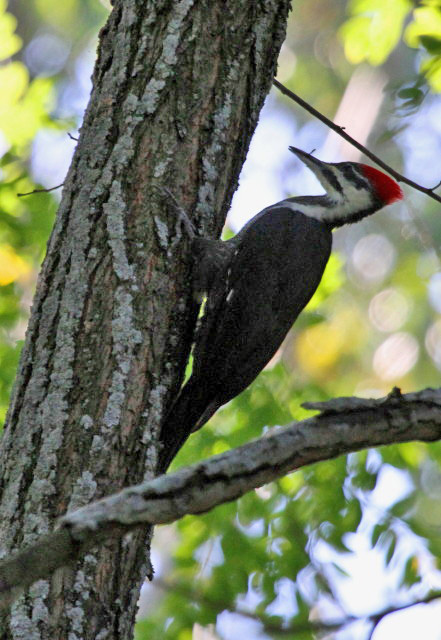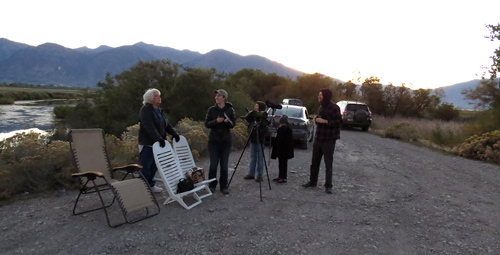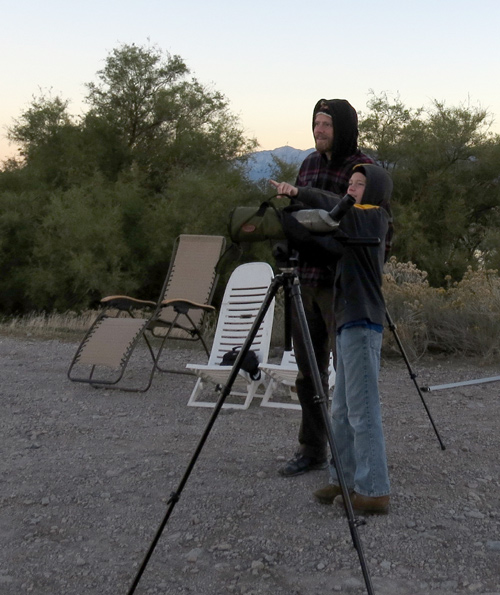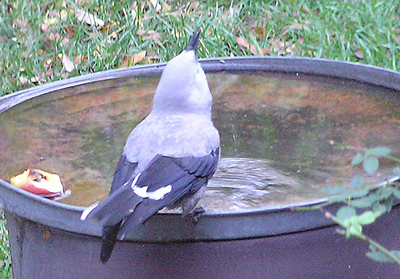Utah County Birders Newsletter
|
 |
Contents
November Meeting
Upcoming Field Trips
Captainís Log
Bird of the Month
Field Trip Report -
The Big Sit.
Backyard Bird of the Month
October Hotline Highlights
NOVEMBER MEETING:
Tuesday, November 10th, 2015 - 7:00 pm.
The meeting this month will be on a different night than
normal.
Jason Robinson from the Utah Division of
Wildlife Resources will be our guest speaker. Jason has agreed to come talk to
us about the recent federal listing decision to not list the
Greater Sage-grouse as threatened or
endangered and what efforts the state and other entities are taking to conserve
sage grouse in Utah.
Meet at 7:00 pm at the Monte L. Bean Museum. 645
East 1430 North, Provo, UT
http://mlbean.byu.edu/
Next month we will return to our normal meeting date.
Saturday November 21st, 2015: 7:30am-early afternoon. Meet at the parking lot at the mouth of Provo Canyon to carpool. We will go on our annual Loon Loop field trip where we will plan to visit some mountain reservoirs in search of Loons and other winter waterfowl. Where we go will be bird sighting and weather dependent. Please come out and join us!
We are actively recruiting people to lead local half-day field
trips, any time, any place. If you would like to lead a field trip or if you
have any ideas for this yearís field trips, please contact Bryan Shirley at -
bt_shirley@hotmail.com
Utah County Birders Captainís Log:
November 2015
by Keeli Marvel
If the weather report is to be trusted it seems like winter will be upon us this
week. Not sure where the time went this year!
A couple of weekends ago Alona and I attended the Birds of Paradise exhibit at
the Utah Museum of Natural History. The exhibit was really very interactive and
informative. It tells the story of how photographer Tim Laman and Cornell
ornithologist Edwin Scholes documented 39 species of Birds of Paradise. It took
them 18 expeditions over the course of eight years to get sound, video, and
photographic recordings. They spent a great deal of time in the absolute middle
of nowhere in Papua New Guinea and northern Australia. The exhibit really opened
my eyes to the diversity of the Birds of Paradise family of birds. They have
some of the most unique and extravagant plumages and some of the strangest and
most elaborate courtship displays I've ever seen. The exhibit was very well
presented and I highly recommend it to anyone with some time available for a
trip up there. It was very interactive and would be great to take children to as
well.
As the year starts drawing to a close, it's time to start thinking about our
birding challenge for next year. If anyone has any input or requests, please
email me. I'll be working on the challenge between now and the end of the year,
so stay tuned!
I submitted my travel and training cost estimate requests at work today and if
they all get approved, it could potentially be a very exciting year bird-wise
for me. The American Ornithologists Union is combining with various other
organizations this year for their annual meeting which will be held in
Washington DC, and according to their website, it's shaping up to be their
largest meeting yet with an estimated 2000 people in attendance. That's 2000
bird nerds! I'm pretty excited about the opportunity to get caught up on the
current research of some of the best ornithologists in the country! I'm also
applying to attend an advanced bird banding course with the Carnegie museum.
That course will be an opportunity to get more hands on experience studying
birds up close. Should be an exciting year coming up!
The Christmas Bird count schedule should be coming out soon. If you've never
participated, or even if you have, we always need more help! Even if you're not
that confident with your ID skills, the best way to get better is by practice
and we can always use the company and another set of eyes! The counts are always
a fun event for those who participate so please consider joining a count circle
this year!
Happy Birding!
Keeli Marvel
 |
|
photo by Eric
Peterson |
Pileated Woodpecker
Dryocopus pileatus
by Yvonne Carter
AH, THE EXCITEMENT OF SEEING YOUR FIRST UNUSUAL BIRD IN ANOTHER
STATE!!!
About eight years ago as I was just starting to birdwatch, I was visiting one of
our sons in Florida in January. Florida is a little different than other
southern states because major companies have transferred part of their business
to Florida. Thus, there are many areas with recent residential developments in
amongst what could be called the 'old' or 'real South'. We have a favorite
'haunt' we visit with our grandkids, a local favorite spot. It is very 'Old
South'. A combination of gas station, and a store with a long, wrap around
porch, old wooden rockers, men coming in and out in bib overalls, and of course,
boiled peanuts are available. My son had gone in to purchase milk and I sat
outside with our three year old granddaughter. My peripheral vision sensed
motion and I turned in that direction to see not ten feet from me a Pileated
Woodpecker perched on the railing. I was so excited and surprised I let out a
little scream that brought my son running out from the store, afraid something
had happened to his little daughter.
A Pileated Woodpecker! You can see them once in a great while in Florida in
winter months and during the summer in the northeast. Our youngest daughter
lived in Renton, Virginia with small forests, ponds and wetlands behind her
home. Visiting her one summer, I discovered a pileated woodpecker up in a tall
tree. They are the largest North American woodpecker -- after the Ivory-billed,
which is believed to be extinct. The Pileated Woodpecker lives in dense, mature
forests. It is locally common in some areas and some claim that they sometimes
stay in the same area all year. In breeding time, it excavates a cavity high off
the ground up to 70 feet, in a dead tree trunk or branch, where it lays 3-5
eggs. These eggs are incubated by both parents for 2-3 weeks, and the young
leave the nest 3-4 weeks after hatching. The male is a large, long-necked
broad-winged woodpecker with a long tail -- length being approximately 16-17
inches. You cannot miss his prominent bright red crest. Its plumage is mostly
black, with a red mustache, a white chin, and a white stripe running across the
face and down the neck. In flight, you can see white under the wings and white
flanks. The female is similar although the red crest is not as bright. The
Pileated Woodpecker eats carpenter ants, which live in dead wood, and also other
wood-boring insects, besides berries.
Another exciting specimen to see is the Painted Bunting. Do you want to know
where you can see six or seven Painted Buntings at one time? I will tell you in
a minute. David Sibley has used illustrations of a Painted Bunting on one of his
books. And I can tell you they are for real. They are really truly blue, green,
and red: Males have indigo-blue heads, bright green back, bright red underparts
and rump and the females are lime green above, lemony-green below. They are
elusive at times and stay in low foliage, nesting not far above the ground. The
young start fending for themselves around 2 weeks after hatching. The Painted
Bunting sings all year round, except when it molts in late summer. It forages on
the ground, looking for insects, spiders and seeds. They are found in southern
Texas and southern Florida although they do go up the coast in the Carolinas in
summer.
Now, to see Painted Buntings during winter months in Florida, head for the Green
Cay Wetlands and Nature Center. Exit I-95 at exit #51 and head west on Highway
806 for about 5-6 miles, turn right on Hagen Ranch Road, drive 2.2 miles and it
will be on your right. At the Nature Center, they keep numerous feeders tucked
back in the trees and that is where I have found those beautiful birds.
THERE IS NOTHING AS EXCITING AS SEEING THESE UNUSUAL BIRDS FOR THE FIRST TIME! A
Birder never forgets that experience.
Yvonne Carter
If you would like to
write an article for the Bird of the Month, please contact
Machelle -
machelle13johnson@yahoo.com
Click here for past 'Birds of the Month'.
Field Trip Report
The Big Sit, Provo Airport Dike - October 10th, 2015
by Keeli Marvel
We had 11 total participants that watched birds from the count circle between
the hours of 6:30am and 6pm (with an hour lunch break). Thanks to everyone who
came out and joined us!
Our species total was 50. This is neither our highest nor our lowest count, but
somewhere in the middle.
The species we saw were:
 |
|
The Big Sit, Provo Airport
Dike |
 |
|
The Big Sit, Provo Airport
Dike |
1- Black-crowned Night Heron
2- Killdeer
3- Song Sparrow
4- Red-winged Blackbird
5-Sandhill Crane
6- Caspian Tern
7- Marsh Wren
8- White-crowned Sparrow
9- American Coot
10- Spotted Towhee
11- Ring-necked Pheasant
12- Snowy Egret
13- American White Pelican
14- Belted Kingfisher
15- Black-capped Chickadee
16- Northern Flicker
17- Pied-billed Grebe
18- Great Blue Heron
19- European Starling
20- Ring-billed Gull
21- Double-crested Cormorant
22- Western Grebe
23- Gadwall
24- American Pipit
25- California Gull
26- Northern Pintail
27- Northern Shoveler
28- Franklin's Gull
29- Downy Woodpecker
30- Clark's Grebe
31- Lesser Scaup
32- Canada Goose
33- House Finch
34- Barn Swallow
35- American Robin
36- Eurasian Collared-dove
37- American Kestrel
38- Black-billed Magpie
39- Mallard
40- Western Meadowlark
41- American Goldfinch
42- Northern Harrier
43- Cedar Waxwing
44- Yellow-rumped Warbler
45- Red-tailed Hawk
46- Osprey
47- Mountain Chickadee
48- Orange-crowned Warbler
49- Ruby-crowned Kinglet
50- Rock Dove (Pigeon)
October 2015
Jack Binch - Sandy
On 27 Oct. I had two Mountain Chickadees in the yard. Pretty rare for me.
Lyle Bingham - Payson
Mountain Chickadee -the first we identified at our feeder in five years.
Yvonne Carter -
Highland
We still have Western Scrub Jay's, Junco's, Chickadees, at
the feeders and I spied Goldfinches in the trees.
Jeff Cooper - Pleasant Grove
Tis the season for accipiters to visit yards with feeders. I didn't have any
active feeders out, but I had a Sharp-shinned Hawk make a brief pass
through the yard October 30th.
Suzi Holt -
Payson
I had a Cooper's Hawk on October 1st. I have had several sharp-shinned
hawks in my yard, but never a Cooper's Hawk. Although it didn't land in the
yard, I did enjoy watching it fly over :)
Eric Huish - Pleasant Grove
Cedar Waxwings - a flock has hung out in the yard a few times this month.
 |
|
Clark's Nutcracker in
Milt's yard. |
Milt Moody - Provo
I was taken aback when a Clark's Nutcracker visited my birdbath in Provo
-- it came two days in a row. The second day I took a picture so I could
prove to myself that I wasn't just imagining things!
Kay Stone - Lehi
We have had two or three Scrub Jays in our yard for about three years. I
put peanuts on the windowsill every morning and try to imitate their call. They
come in sometimes while I am still putting the peanuts out and then bury them in
my or my neighbors backyard. They will later come and dig them up and eat them.
If I am late putting the peanuts out they will be waiting on my rain gutter
waiting for me to supply the food. They will bob their heads up and down and
click their bills together very rapidly waiting for their food. I guess I have
made them welfare birds, but they are really fun. - p.s. My neighbor Jim
Strong also feeds the same birds
Alton Thygerson - Provo
Spotted Towhee - not a frequent visitor but should be as the winter
approaches.
Report your favorite backyard bird
each month to Eric Huish at 801-360-8777 or
erichuish@gmail.com
The Utah County Birders Newsletter is now online only/mostly.
We've decided to stop the regular paper mail version of the UCB Newsletter. This will save our club on Printing, Postage and Paper. If you would like an email notice each month when the Newsletter is posted online please send an email to Eric Huish at erichuish@gmail.com.
We are willing to print the online version of the newsletter and mail it out to anyone who still wants a paper copy or who doesn't have internet access. If you know of anyone who enjoys the UCB Newsletter but doesn't have internet access please let Eric Huish or Keeli Marvel know and we will make sure they get a copy.
Printable Version of this UCB Newsletter